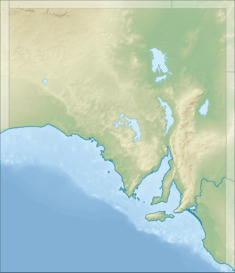Hindmarsh Valley Reservoir facts for kids
Quick facts for kids Hindmarsh Valley Reservoir |
|
|---|---|

Wall at Hindmarsh Valley Reservoir
|
|
|
Location of Hindmarsh Valley Reservoir in South Australia
|
|
| Official name | Hindmarsh Valley Reservoir |
| Country | Australia |
| Location | Hindmarsh Valley |
| Coordinates | 35°28′16″S 138°36′05″E / 35.470982°S 138.601296°E |
| Purpose | potable water supply |
| Status | recycled water storage |
| Construction began | November 1914 |
| Opening date | 25 June 1917 |
| Construction cost | A£69,000 |
| Owner(s) | Government of South Australia |
| Operator(s) | SA Water |
| Dam and spillways | |
| Type of dam | Gravity |
| Height (thalweg) | 13.6 metres (44.5 ft) |
| Spillways | 1 |
| Reservoir | |
| Creates | Hindmarsh Valley Reservoir |
| Total capacity | 590 megalitres (130,000,000 imp gal) |
| Active capacity | 360 megalitres (80,000,000 imp gal) |
| Catchment area | 9.1 square kilometres (3.5 sq mi) |
| Normal elevation | 69 metres (227 ft) |
The Hindmarsh Valley Reservoir is a large water storage area in South Australia. It is located in a place called Hindmarsh Valley, about 11 kilometers (7 miles) north of Victor Harbor. This reservoir has a dam wall that is about 13.5 meters (44.5 feet) high. It holds a huge amount of water, about 363 million liters (80 million imperial gallons), and the lake stretches for about 0.8 kilometers (0.5 miles).
Contents
Building the Reservoir
The Hindmarsh Valley Reservoir was planned and built by the state government's Waterworks Department. Construction began in November 1914 and finished in mid-1917. Most of the work involved digging out a natural dip in the land. Workers then built a strong dam wall with a special clay core to hold the water back.
Where the Water Comes From
The reservoir was designed to get water from two main places. First, it collected rainwater that flowed from nearby hills like Mount Billy and Peeralilla Hill. Second, and most importantly, it received water from the Hindmarsh River. This river water was brought in through a special intake chamber and large concrete pipes that were about 60 centimeters (24 inches) wide.
Who Used the Water?
When it was first built, the reservoir's main job was to supply drinking water to towns like Victor Harbor, Middleton, and Port Elliot. Later, people in Goolwa asked the government for water, so the pipes were extended to their town too. In 1978, a new spillway was added to the dam, which helps control the water level.
Protecting Nature
In 1983, the land around the reservoir was recognized as an important natural area. It was listed on the now-closed Register of the National Estate. This area has many different types of plants, including beautiful blue gum and manna gum trees. The reservoir itself also adds to the natural beauty and provides a home for various animals.
Changes Over Time
By 1999, the reservoir was no longer needed as much by SA Water, the company that operates it. There were plans to give the land to the Department of Environment and Natural Resources. This would allow them to protect the area while still letting SA Water access the dam.
In August 1999, the land just north of the reservoir became part of the Mount Billy Conservation Park. This park helps protect the native plants and animals in the area.
A New Plan
In November 1999, the government announced that the Hindmarsh Valley Reservoir would be "decommissioned," meaning it would stop being used for its original purpose. A new facility, called the Nettle Hill Water Storage Facility, was built nearby to take its place. This new facility gets treated water from the Myponga Reservoir.
What's It Used For Now?
As of 2007, the Hindmarsh Valley Reservoir is used to store "recycled water." This is water that has been treated at the Victor Harbor Waste Water Treatment Plant. It helps manage extra water during different seasons.
Fun Activities?
In September 2014, the reservoir was one of five water storage places considered for fun activities like fishing. However, as of January 2018, the necessary approvals for public recreation had not yet been given. So, for now, it is not open for these kinds of activities.


